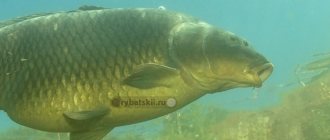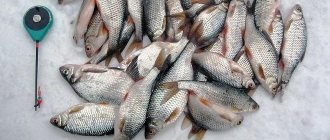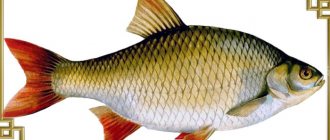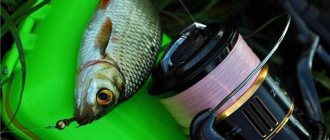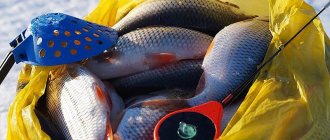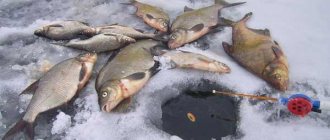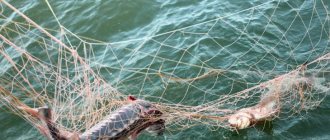- How to catch rudd with a jig in winter
- Jig for rudd in winter with float rig
Rudd can be caught with a jig just as successfully as any other fish that does not go into suspended animation in winter.
In addition, it is during this period that large specimens can be harvested. But they fish for it in a completely different way than for roach or silver bream. This is associated with the lifestyle of the rudd, which more often prefers to stay in the upper horizons of the water, where fishermen catch it. She also stays there in the summer, without changing her rules. And the more abundant the thickets, the more at ease she feels, moving through the same places at any time of the year.
No bait fishing from ice
In winter, fish are always caught using a reelless bait, despite the popular belief that it is better to fish with a baitless bait on the first or last ice, when underwater inhabitants are actively looking for food. Like any other type of ice fishing, reelless fishing in winter relies on knowledge and use of the behavioral characteristics of specific species, reservoir conditions, weather and seasonal changes. In fact, reelless fishing is much simpler than some fishermen think. It’s just that at the beginning of your journey you shouldn’t delve into all the nuances and subtleties - knowledge will come with experience. You need to start with the basics, then a bite from a curious roach or perch will not take long to come. The fish takes a baitless bait even when it is not feeding, the main thing is the correct tactics and technique. Let's look at the basics of baitless fishing.
Lure
Bait, sprinkled periodically in small portions directly into the hole, is important in catching rudd. It can be sunflower cake pre-steamed in boiling water mixed with black bread or breadcrumb crumbs mixed with semolina. As a result, an odorous cloud of nutritious turbidity appears in the hole, which attracts rudd.
Remember that rudds always stay in a flock. Therefore, having pulled out one fish, get ready to catch its relatives as well. So the more holes there are in the ice, the better for the overall fishing result.
Basic principles of rewinding
For beginners, a reelless reel sometimes turns into a stumbling block - it doesn’t bite and that’s it. The main mistake in this case is searching for the most catchy bait or the best way to play. You need to start not with this, but with the fundamental principles of mothless. More often, beginners’ mistakes are hidden in a globally incorrect approach to this type of fishing. The two most important postulates of the mothless method:
- The main thing in playing with a jig is monotony . Although some people mistakenly believe that the required oscillation frequency is more important. It’s better to play sluggishly, but monotonously, than to provide a high frequency, while allowing glitches in the game. It’s enough to lose the rhythm once – and the fish that seems to approach will no longer grab the reeler. First you need to accustom yourself to a clear, well-thought-out game without parasitic movements of the mothless in the water. The ability to play high-frequency will come with experience, gradually, and the ability to seduce fish without a bait will expand.
- The first point can only be achieved with the right equipment. It doesn’t matter what kind of reelless jig is used - the fishing equipment is a single system - bait, fishing line, nod, and the angler’s hand. In the case of hookless gear - bait, fishing line, whip, hand. Elements of equipment are carefully selected according to the weight of the bait (more on this later). The fisherman must feel the jig and the fish touching the bait. There are no bloodworms on the hook; the fish’s interest in such fishing is aroused only by the correct movements of the bait in the water. Therefore, gear for reelless fishing is thin fishing lines, sensitive nods, ultra-light fishing rods. What is important for fishing is, rather, not the small thickness of the fishing line, but its stretching into an even line under the weight of the bait. In principle, for an amateur, 0.1 mm - for light jigs, 0.12 - for heavy jigs, is enough.
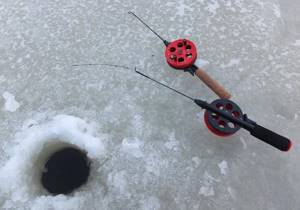
The right approach to nozzle
Here are some other recommendations that you must constantly follow when fishing in winter with reelless jigs (over time this happens automatically):
- The correct grip of a fishing rod is two fingers (or three, like a pencil). This is the only way to achieve correct high-frequency brush play.
- What is important is the time during which the angler manages to identify and realize that a bite has occurred. Reaction speed is the key to the success of baitless fishing. If there is a nod, the bite is determined visually, then the brain signals the hand to strike. In the no-kick version of fishing, the reaction is a fraction of a second shorter - the bite is felt tactilely, in the hand, and an experienced brush immediately cuts through the fish automatically.
- The game is a constant experiment. There is no magic trick - each angler develops his own unique game. Yes, you need to rely on the basic options of the game, but with experience, elements appear in the wiring, often occurring on the machine, specific to each person. These are micro movements of the hands, trembling of the fingers. Even when paused, a reelless baitfish is never completely motionless – the bait is connected to the angler’s hand by fishing line and tackle.
- Instant hooking when biting is a prerequisite. There is no edible bait on the hook - the fish will try to immediately spit out the bait.
- The most important element of the nozzle is the decoration of the hook (if the nozzle does not entirely repeat the shape of a natural amphipod or bug). This is the attack point for the fish. Beads, balls, and cambrics are most often used. The beads are not fixed tightly - they should move freely along the fore-end when playing, making their own micro-oscillations and tapping. The color of the moth is also important - not a monochromatic decoration, but a contrasting one works better. Black with yellow, green with red, etc.
- Initially, several Urals or ants are taken into service, and the correct technique and tactics are developed. Success in reelless fishing depends on the personal skill of the angler, and not on specific baits. Next, after gaining successful fishing experience, you can immerse yourself in studying the multifaceted variety of shapes and colors of reelless baits, looking for interesting working options.
- A wormer always has several pre-set, selected gear in his arsenal. It is the fishing line, nod and fishing rod that are matched to the weight of the bait and fishing depth, and not vice versa. Therefore, order is needed in the box - all jigs are arranged by weight in groups corresponding to the fishing rods in service. A specific reelless reel can only be used on gear suitable for its weight with the appropriate fishing line thickness and the elasticity of the nod (whip structure). The reeler does not exchange a light jig for a heavy one and vice versa on the same fishing rod. While fishing, he takes out another ready-made tackle from the box, balanced to the desired jig. Small deviations in the weight of the bait are allowed per nod, which can be eliminated by adjusting the length of the guard (if the design allows).
- Fishing is always gentle, but assertive. The range of lines used is 0.06-0.12 mm, no more, even for large fish. Maximum attention is paid to equipment, more than in other fishing methods. In reelless fishing, the angler has no room for error.
- The main fishing tactic is to actively search for fish. The further you go, the higher the likelihood of a good catch. In the tactics of reelless fishing there are nuances associated with the variability of water conditions.
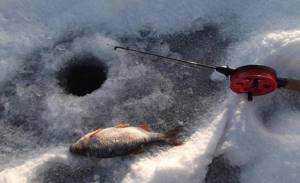
Rudd bite in winter
The bite is expressed, as a rule, in a slight “sinking” of the float. Occasionally it happens (most often, during periods of famine) that a rudd takes a “flood”, dragging a light float under the ice. There are times when the fish stops actively getting hooked and only moves the float slightly. It is during these movements that you need to strike. The rudd (especially the large ones) resist quite actively. Therefore, when catching large fish, it is recommended to “darken” the hole with snow and only then continue fishing.
Fishing tactics
Let's look at how to properly fish with a reelless bait from a tactical point of view. Depending on the conditions of the reservoir, fishing tactics differ. During first ice and at the end of winter, the best method is to actively search over as wide a water area as possible. In the dead of winter, a thorough fishing of a specific promising place with a reaperless fish is carried out. The tactics directly depend on the type of fish - fishing for perch and bream, for example, are very different.
Active search
Rewinder on the first ice - Eldorado for beginners. You don't need to worry too much about tactics. Several holes are drilled, which are fished in turn. Next is moving to a new place. The nature of fishing depends on the goal that the fisherman has set for himself. Ideally, this is fishing for a specific type of fish. Tactics are selected depending on the seasonal characteristics of the behavior of perch, bream or roach. This is described in more detail in the relevant articles on our website (links below). If you just went out to catch whoever you came across, then an active search, a lot of movement, is the basis of fishing with a reelless reel on the first ice. Any promising places are checked - areas near aquatic vegetation, edges, slopes going to the depth of the spit, steps, snags.

Glukhozimye
In the dead of winter, it is more difficult to catch passive fish with a reelless fish. First of all, you need to find a cool place first. The fish moves little at this time, and often stands still, without going far. At such times, knowledge of the bottom topography is important. The absence of bites does not mean that there are no fish in the fishing area. To provoke underwater inhabitants, you may need to rock the holes or use bait. If there is an accurate understanding that fish are present here, then you should pay more attention to fishing with various reelless baits, changing the colors and sizes of jigs, experimenting with the method of play. Playing with a reelless reel requires more sluggish, uniform and monotonous play.
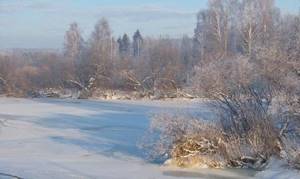
Lure
The technique and tactics of fishing with a reelless bait involves the use of bait (in some cases). This is especially true when searching for roach or bream. The purpose of bait is to lure the fish and force it to constantly remain in the fishing zone. Bait is necessary if fishing takes place in vast water areas without obvious anomalies in the bottom topography (for example, in a reservoir). You can wander around the snowy field endlessly, but you still won’t find the fish. On large rivers the situation is similar, however, when fishing with a reelless bait in the current, feeding is done in a separate hole above the direction of the water flow, with a special feed.
Several holes are drilled in the selected location - up to 10, at a distance of 5-7 meters. Each is fed with a small dose of fertilizer, and then checked with a jig. During the initial check, a working reelless reel is used, which has already fished in these places. When there is a bite in a hole, we feed it thoroughly and move on to thorough fishing with various baits or baits until a working option is determined. Further fishing proceeds depending on the clarified characteristics of the bite.

Reelless jigs
There are a great many varieties of jigs for reelless fishing in winter. Each bait is characterized by some specific, unique features. Among the standard hookless hooks with one hook, to begin with, select a couple of universal options of different sizes and colors. For example, silver and black uralochki, ants, droplets with various options for decorations on the hook. A beginner needs to learn how to fish with basic jigs, having clearly mastered the tactics and techniques of fishing. A popular bait for winter fishing with a reelless bait is devils (with a soldered tee) or devils (with a dangling hook on a ring), and their various variations. An article about winter fishing for devils.
We start experimenting with colors of decorations and shapes of mothless fish later, after mastering the basics of fishing. First, you need to master the simplest rewinders. The bite is affected by the color of the beads, the size and, in fact, the configuration of the reel. You shouldn’t look for a magical version of a super-catchy bait - there are none. Over time, the supply of mothless moths in the box will increase. Read more about the types of reelless jigs.

The most catchy baits for rudd
- a burdock larva (burdock moth) is placed on the smallest hook in its middle;
- caddisfly and amphipod larvae are used for capricious biting when other baits do not work;
- bloodworm larvae - they can be obtained all year round by scooping up bottom sludge and then washing it in a sieve or sieve;
- maggot - it is pinned onto the hook under the thickening of the body, revealing the hook's tip;
- dough colored pink (for example, by adding lipstick).
Fishing rod equipment
The basic basis of reelless fishing is the correct equipment of the fishing rod. A light balalaika will do for starters. Several fishing rods can be adjusted at once, for example, with a 0.12 mm line for heavy devils and 0.1 mm for small drops. Next, when diving into the specifics of fishing with a baitless jig, you should get ultra-light fishing rods or try a nodule-free rig.
The lighter the fishing rod, the easier it is to control the game, the less your hand gets tired during the day. At the initial stages, more attention is paid to the selection of fishing line, nod and weight of the reel. Then this is done automatically. Without the right balance, you won't be able to create the game you want. The line is high-quality winter fluorocarbon with low memory. The bobbins of winter reels or reels are minimal in diameter. And in working condition, the reelless reel should pull the line into a straight line in the water, leaving no waves. Since the fishing line is thin, the process of emergency release of the stock is thought out if a large fish is caught. An article about fishing rods for reelless fishing.
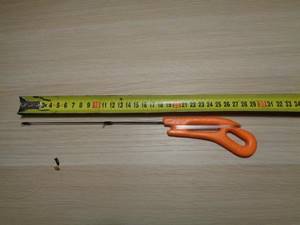
Combination of nod - jig - fishing line. This is the basic law of rewinding. A corresponding nod is selected for each bait. Fishermen use various options - lavsan, metal, boar bristles. Store-bought lavsan nods require improvement. To do this, the form is carefully sanded to achieve the correct position under load. The setup is done at home in advance, for example, in an aquarium or in a bucket of water. Read more about the correct nods for a rewinder. The nod in the finished state turns out to be slightly underloaded. When twitching upward, the guard should seem to lift the weight of the bait from the water, but without jumps and springy bouncing.

Noduleless moth
The pinnacle of reelless fishing is fishing with ultra-light fishing rods without a nod. Kinkless fishing rods for reelless fish work on the principles of baitless fishing, however, a fine match must be achieved in such gear between the weight of the bait and the sensitivity of the whip. More often, fishermen make such gear themselves. The simplest option is a wine cork and a coal whip stuck into it. The most difficult thing is refining and selecting a whip for the weight of the jig. The tackle in working position should allow the angler to feel the game.
The sensitivity of such a fishing rod is maximum - the time from bite to hook is minimal. The slightest attempts of the fish to touch the bait are felt by hand. This tackle gives better contact with the bait and fish when playing and biting. What is important here is the length of the whip, which is selected individually based on the fisherman’s usual posture during jig fishing.
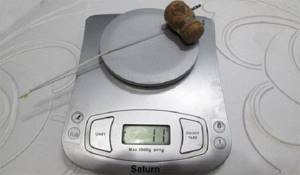
When is the best time to go for a trophy?
There is an opinion that you should catch rudd in winter only before lunch. However, some experienced fishermen do not confirm the decrease in its biting activity in the afternoon. Moreover, their experience suggests that the rudd bite only intensifies in the afternoon on sunny days.
On fine winter days this fish is as active as in summer. Living in shallow places overgrown with reeds, the stems of which pierce the ice and allow air oxygen to reach the water, the fish takes full advantage of this favorable circumstance. Therefore, being pinned, it initially offers strong resistance, which does not last long. After that it’s not so difficult to pull it to the hole.
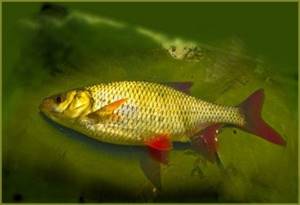
However, if you come across a large specimen weighing up to 1 kg, then you need the fishing line to have a safety margin, and you should not rush to land the fish. Let her get a little tired by smoothing out her jerks with your hand.
Reelless fishing technique
Correct play with a reelless bait is the very essence of baitless fishing. However, you should not try to study all 100,500 wiring methods and apply them on a pond. You need to start with a couple of basic wiring methods, achieving results, and then improve, adding personal bits of experience. As already mentioned, it is important not to blindly repeat memorized combinations, but to play the game monotonously, without parasitic glitches. A sense of rhythm will help you fish correctly with a reelless bait. You can, for example, hum something rhythmic to yourself (and this is not a joke). Playing with a jig without an attachment is so multifaceted that there is simply no point in listing all the wiring methods. Here you need to get good at basic movements, catch a sense of rhythm, and then add moments that are provocative for the fish, without breaking the main rhythm.
The technique of baitless fishing in winter depends on the type of fish and seasonal factors. Some species prefer more active and rhythmic play, while others prefer smooth and sluggish play. When fishing in the dead of winter, there are long pauses in the game; closer to spring, they are short. The subtleties of fishing with a reelless bait come with experience and more than a dozen fish caught. The technique of retrieving and the action of a reelless jig is constantly being improved on every fishing trip. We can only give general recommendations and advice on reeling for beginners - the angler will have to figure out the nuances on his own; no theory will help here.

Horizontal grip
Basic techniques for playing with a rewinder:
- Dribbling. High-frequency trembling of the bait. Used in various options. Smooth rise with constant trembling, lowering, alternating dribbling and calm pulling.
- Evenly moving or lowering (or with acceleration)
- Threshold. More amplitude and lower frequency vibration. It is set not by shaking your hand, but by tapping the rod with your finger.
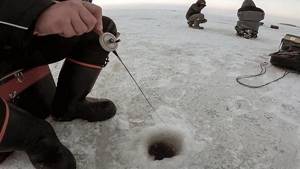
Depending on the fishing conditions or type of fish, various combinations can work:
- Okunevaya – slow rise with high-frequency and low-amplitude dribbling. After raising to the maximum level, reset, short pause and immediately repeat the cycle. Read more in the article about catching perch with a reelless reel.
- Roach – the rise is the same as for perch, only weaker in frequency, smoother. Then lowering by steps. Often the roach takes to the reelless position precisely on the descent.
- Bream - a smooth or stepwise rise, the same descent, without dribbling, can be done evenly or slightly with a nod. At the lowest point you can tap on the bottom. About catching bream in winter with devils.
- Classic jig - movements reminiscent of amphipods jerking in water, lifting up or down at different speeds, long pauses and amplitude (2-7 cm).
- Universal - dribbling 2-3 cm at the bottom, lifting 10-15 cm with an amphipod, lowering.
The main task is to perform a certain combination several times in the same way, without changing the frequency, amplitude and distances. Failures are not acceptable. As a provocation, after several cycles you can pause in the “wrong” place - this can provoke the fish to bite. Another option for provocation is a change in speed or amplitude. It is also important to play monotonously and without interruptions after a shift.
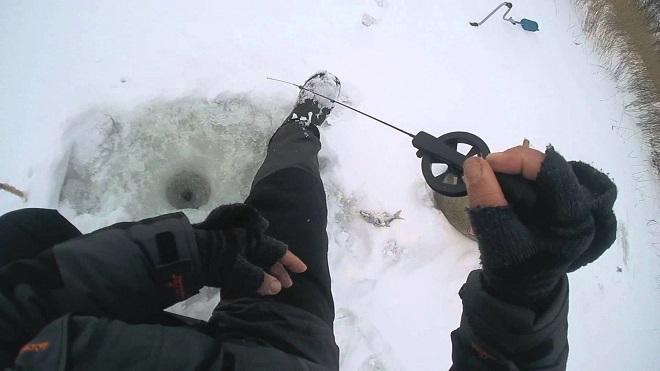
Features and nuances of fishing
Reelless fishing in winter lures the angler into its arms after the first fish caught - and all because of the close contact, the feeling of a bite with your own hands. Fishing with a baitless jig is a new level in fishing. To successfully apply the method, the angler will have to rethink some things that may be familiar from fishing with a bloodworm bait.
To fish with a reelless bait in winter, the contact between the angler and the gear is important. This is impossible with thick winter gloves. Therefore, hands should be at least partially hardened to the cold. In severe frosts, special gloves with opening fingers or fishing in a tent are used.
Some anglers use a vertical grip of the fishing rod, holding the tackle with their fingers by the balalaika with the whip down, like a pencil. The nod with such a grip is almost not involved in the game, but serves to fix the bite. This is a kind of transitional format between nod and nodless rewinders. In any case, when fishing with a baitless jig, you need to hold the rod with your fingers and play with a brush; this is the only way to achieve correct high-frequency play.
